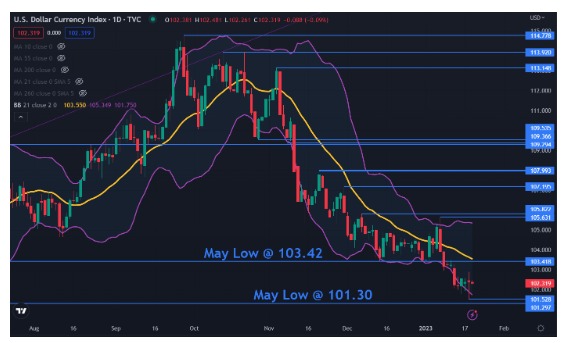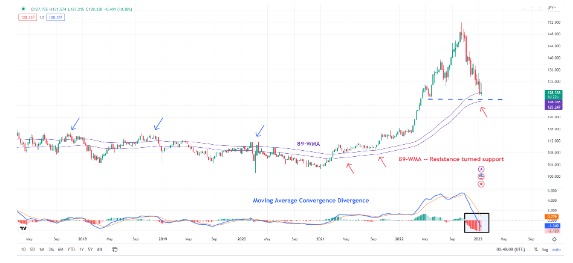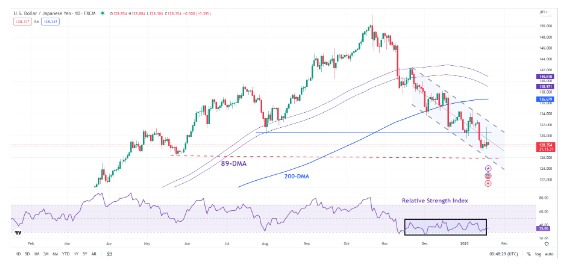The US Dollar experienced fluctuations before stabilizing on Wednesday. Meanwhile, the AUD, NZD, and JPY have been impacted by recent data and news. The Federal Reserve’s direction is clear, but the extent and speed of their actions remain uncertain.
The US Dollar recovered from an eight-month low after soft data painted a concerning picture followed by several Federal Reserve talking tough on further rate hikes.

Table of Contents
ToggleRetail Sales
US retail sales for December were -1.1% month-on-month instead of the -0.9% anticipated and -0.6% prior. PPI for the same period was -0.5%, notably lower than the 0.1% forecast and 0.3% previously.
The numbers triggered fears of a recession and Wall Street finished the cash session lower with the major indices down well over a percent. Microsoft and Amazon announcing job cuts to their workforce didn’t help the mood.
Then a cavalcade of Fed speakers reminded markets of the impending rate hikes. Some pointed to 25 basis points (bp) being the most appropriate steps while St Louis Fed President James Bullard put the case forward to tighten more aggressively.
This pushed equities lower but assisted the US Dollar. The 2s 10s Treasury curve inverted another 5bp toward -0.70% on a bull flattening.
Federal Reserve Rate Hikes
The US Dollar, which had been struggling at an eight-month low, made a recovery after a series of statements from Federal Reserve officials indicated that they were planning on implementing further interest rate hikes.
These statements came in response to soft economic data that raised concerns of a potential recession.
The US retail sales for December were -1.1% month-on-month, which was worse than the -0.9% that had been anticipated and the -0.6% from the previous month.
Additionally, the producer price index (PPI) for the same period was -0.5%, which was much lower than the 0.1% forecast and the 0.3% from the prior month.
These numbers sparked fears of a recession, and Wall Street finished the cash session lower, with the major indices down by well over a percent. The news that Microsoft and Amazon were cutting jobs from their workforce did not help to improve the overall mood.
However, a series of statements from Federal Reserve officials, who reminded markets of the impending rate hikes, helped boost the US Dollar.
Some officials suggested that 25 basis points (bp) were the most appropriate steps to take, while St. Louis Fed President James Bullard argued for a more aggressive tightening of monetary policy.
This caused equities to decline but assisted the US Dollar. The 2-10 year Treasury curve inverted another 5bp towards -0.70% on a bull flattening.
Bank Of Japan Announcements
The Japanese Yen also strengthened as the trade deficit for December came in at ¥ -1.448 billion, which was better than the estimates of ¥ -1.670 billion. The easing of energy prices and the overall weaker Yen may have contributed to this positive outcome for the archipelago nation.
Additionally, the Bank of Japan announced a technical tweak to its yield curve control (YCC) program, which some commentators have equated to a slight easing in policy.
Australian Dollar and New Zealand Dollar Performance
Meanwhile, the Australian Dollar stumbled after the jobs data for December came in worse than expected. The unemployment rate was 3.5%, which was higher than the 3.4% that had been anticipated and the previous month’s rate.
Employment also fell by 14k, while forecasts had predicted an increase of 25k.
Australian Commonwealth Government Bonds (ACGB)
This caused the Australian Commonwealth Government Bonds (ACGB) to join long-end Treasury yields in decline, with the 10-year collapsing around 30 bp.
The bond is currently trading near 3.30% compared to 4.1% at the end of last month.
The New Zealand Dollar also slipped after Prime Minister Jacinta Ardern announced her resignation on February 7th, citing that she “did not have enough in the tank” to continue in the role.
Crude Oil Prices
Crude oil prices were also under pressure, with the WTI futures contract trading under US$ 79 per barrel and Brent trading below US$ 84 per barrel.
On the other hand, gold prices were on the rise as it approached US$ 1,910 per ounce.
Looking ahead, ECB President Christine Lagarde will be speaking from Davos and some Fed speakers will also be crossing the wires. Later on, the US will see data on housing starts, building permits, and initial jobless claims.
Traderfactor’s Economic Calendar provides you with the latest economic events
US Dollar Analysis
The US dollar, also known as the greenback or USD, is one of the most widely traded currencies in the world. It is the primary currency used for international transactions and is considered a safe-haven currency during times of economic uncertainty.
The value of the dollar is impacted by a variety of factors, including interest rates, inflation, and political and economic conditions both in the US and globally.
Technical analysis can be applied to the USD, as with any other currency, to gain insight into its short-term and long-term performance.
This type of analysis involves studying charts and historical data to identify patterns and trends in the currency’s value, as well as monitoring key technical indicators such as moving averages and support and resistance levels.
Fundamental analysis, which involves evaluating economic and political factors that can impact the currency’s value, is also important in understanding the performance of the USD.
Interest rates, inflation, GDP growth, and trade relations are among the key fundamental factors that can influence the dollar’s value.
Overall, the USD is closely watched by investors and traders globally, and a combination of both technical and fundamental analysis can provide valuable insight into its performance and potential future movements.
Current Trading
Yesterday, the DXY index reached a low of 101.53, which is just above the May low of 101.30. These levels may act as support for the index going forward.
Additionally, the recent drop in the DXY index also broke through the lower band of the 21-day simple moving average (SMA) based Bollinger Band, which is often seen as a bearish signal.
However, the index closing back inside the band could indicate a temporary halt in the bearish trend or a potential reversal.
As for resistance levels, the DXY index may face challenges at the breakpoint of 103.42 or at the previous peaks of 105.63 and 105.82. These levels could potentially limit the upward movement of the index.

Chart from trading view
What Are The Potential Future Movements Of The Usd/JPY Currency Pair Following The Bank Of Japan’s Recent Actions?
The USD/JPY currency pair is currently approaching a crucial level of support, as it appears that the recent slide in value is beginning to slow down. Traders and investors will be closely monitoring the pair to determine the outlook and identify key signposts to watch.
The USD/JPY pair has been on a downtrend for some time now, but the rate of decline has slowed in recent days.
This could be an indication that the pair is nearing a support level, which could serve as a floor for the currency and prevent it from falling further.
One important factor to consider is the Bank of Japan’s (BoJ) recent actions and their impact on the pair.
The BoJ has been known to intervene in the currency markets to stabilize the yen, and any further actions or statements from the central bank could have a significant impact on the USD/JPY pair.
Another key signpost to watch for is any changes in the relative strength of the US and Japanese economies. The health of the US economy, as measured by indicators such as GDP growth and employment, can have a major impact on the value of the dollar.
Similarly, the state of the Japanese economy, as measured by indicators such as industrial production and inflation, can also influence the value of the yen.
In addition, traders and investors will also be closely monitoring the global economic and political developments, especially the US-China trade talks and the risk sentiment in the market, as these events can also affect the currency pair.
Overall, the outlook for the USD/JPY pair is uncertain, and traders and investors will need to pay close attention to key signposts such as support and resistance levels, central bank actions, and economic indicators to gain insight into the pair’s future movements.
USD-JPY Short-term Outlook
The inability of the Japanese yen to maintain losses against the US dollar on Wednesday may indicate the current sentiment since the end of 2022. The USD/JPY currency pair experienced a 2% increase following the Bank of Japan’s decision to maintain its loose monetary policy.
However, the gains were not sustained due to the release of poor US retail sales figures, which reinforced the perception that the US economy is slowing down.

The retracement of the intraday gains in USD/JPY on Wednesday highlights the significant downward trend that has been present in the currency pair recently.
This can be seen on the weekly chart, where the price of USD/JPY has been trending downwards over the past few weeks.
The retracement of the intraday gains further confirms this trend.
The Moving Average Convergence Divergence (MACD) indicator is a widely used technical indicator that can be used to determine the strength and direction of a trend.
A bearish trend is indicated by a negative value of the MACD indicator, while a bullish trend is indicated by a positive value.
In this case, the MACD indicator is at its lowest level since 2018, which is a clear sign of the extent of bearishness surrounding the USD/JPY currency pair.
This also could be a reflection of the mood prevailing since the end of 2022, as the US economy is showing signs of slowing down, which is affecting the USD, and the Bank of Japan is sticking with its ultra-easy monetary policy, which is affecting the JPY.
This is causing investor sentiment to shift towards a bearish outlook for the currency pair.

Despite the bearish trend that has been present in USD/JPY recently, it is important to note that the multi-week slide in the currency pair appears to be losing momentum.
Wednesday’s jump in the USD/JPY exchange rate could be a sign that the tide may be turning in favor of the US dollar.
This is because the currency pair is approaching a strong level of support on the 89-week moving average, which coincides with the May 2022 low of 126.30.
So far, USD/JPY has not broken any key levels of resistance, starting with the 89-period moving average on the 240-minute chart.
The rallies seen in recent weeks have been unable to break above this level, which has acted as a barrier for the currency pair.
However, the fact that the slide is losing steam, and the approach of strong support, could suggest that the tide could soon be turning in favor of the US dollar. This is something that traders and investors should keep an eye on as the situation develops.

An upward movement above the 89-period moving average on the 240-minute chart, which is currently close to the upper limit of a downward trend that has been in place since November, would suggest that the prolonged bearish pressure on USD/JPY is beginning to wane.
This is highlighted by the fact that recent lows in the daily charts haven’t been accompanied by corresponding lows in momentum, indicating that the downward trend is weakening.
Get A Comprehensive Forex Trading Guide Here

Read the following in the Forex Education Section
- Beginners Guides and Tips For Forex Trading
- Read A Beginners Guide To Forex Trading
- Mistakes Most Beginner Forex Traders Make and How To Avoid Them
- A 2023 Beginners Guide To Buying And Selling Currencies
- Can You Make Money Trading Forex In 2022 and 2023: Here Are The Facts
Disclaimer:
All information has been prepared by TraderFactor or partners. The information does not contain a record of TraderFactor or partner’s prices or an offer of or solicitation for a transaction in any financial instrument. No representation or warranty is given as to the accuracy or completeness of this information. Any material provided does not have regard to the specific investment objective and financial situation of any person who may read it. Past performance is not a reliable indicator of future performance.

















